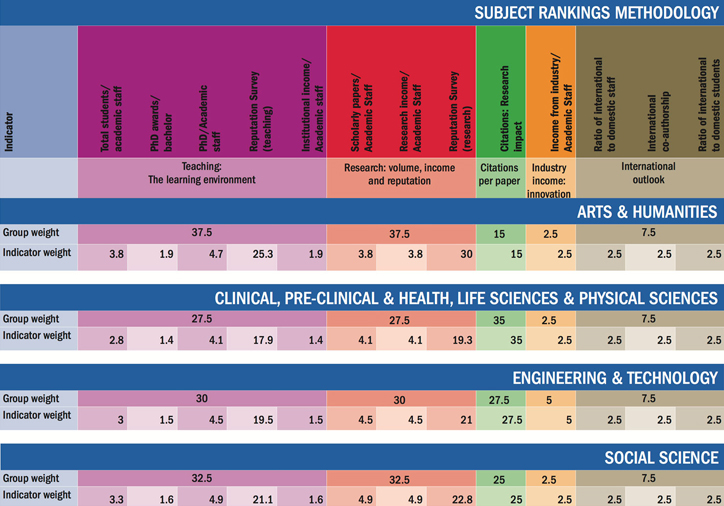The Times Higher Education World University Rankings are the only global performance tables that judge research-intensive universities across all their core missions: teaching, research, knowledge transfer and international outlook. We use 13 carefully calibrated performance indicators to provide the most comprehensive and balanced comparisons, trusted by students, academics, university leaders, industry and even governments. The basic methodology for this year’s rankings is similar to that employed since the 2011-12 tables, but we have made important changes to the underlying data.
The performance indicators are grouped into five areas:
- Teaching (the learning environment)
- Research (volume, income and reputation)
- Citations (research influence)
- International outlook (staff, students and research)
- Industry income (knowledge transfer).
Note on comparisons with previous years
Because of changes in the underlying data, we strongly advise against direct comparisons with previous years’ World University Rankings.
Exclusions
Universities are excluded from the World University Rankings if they do not teach under-graduates or if their research output amounted to fewer than 200 articles per year over the five-year period 2010-14. In exceptional cases, institutions below the 200-paper threshold are included if they have a particular focus on disciplines with generally low publication volumes, such as engineering or the arts.
Data collection
Institutions provide and sign off their institutional data for use in the rankings. On the rare occasions when a particular data point is not provided – which affects only low-weighted indicators such as industrial income – we enter a low estimate between the average value of the indicators and the lowest value reported: the 25th percentile of the other indicators. By doing this, we avoid penalising an institution too harshly with a “zero” value for data that it overlooks or does not provide, but we do not reward it for withholding them.
Getting to the final result
Moving from a series of specific data points to indicators, and finally to a total score for an institution, requires us to match values that represent fundamentally different data. To do this we use a standardisation approach for each indicator, and then combine the indicators in the proportions indicated below.
The standardisation approach we use is based on the distribution of data within a particular indicator, where we calculate a cumulative probability function, and evaluate where a particular institution’s indicator sits within that function. A cumulative probability score of X in essence tells us that a university with random values for that indicator would fall below that score X per cent of the time.
For all indicators except the Academic Reputation Survey, we calculate the cumulative probability function using a version of Z-scoring. The distribution of the data in the Academic Reputation Survey requires us to add an exponential component.
Teaching (the learning environment): 30%
- Reputation survey: 15%
The Academic Reputation Survey (run annually) that underpins this category was carried out in December 2014 and January 2015. It examined the perceived prestige of institutions in teaching. The responses were statistically representative of the global academy’s geographical and subject mix. - Staff-to-student ratio: 4.5%
- Doctorate-to-bachelor’s ratio: 2.25%
- Doctorates awarded-to-academic staff ratio: 6%
As well as giving a sense of how committed an institution is to nurturing the next generation of academics, a high proportion of postgraduate research students also suggests the provision of teaching at the highest level that is thus attractive to graduates and effective at developing them. This indicator is normalised to take account of a university’s unique subject mix, reflecting that the volume of doctoral awards varies by discipline. - Institutional income: 2.25%
This measure of income is scaled against staff numbers and normalised for purchasing-power parity. It indicates an institution’s general status and gives a broad sense of the infrastructure and facilities available to students and staff.
Research (volume, income and reputation): 30%
- Reputation survey: 18%
The most prominent indicator in this category looks at a university’s reputation for research excellence among its peers, based on the responses to our annual Academic Reputation Survey. - Research income: 6%
Research income is scaled against staff numbers and adjusted for purchasing-power parity (PPP). This is a controversial indicator because it can be influenced by national policy and economic circumstances. But income is crucial to the development of world-class research, and because much of it is subject to competition and judged by peer review, our experts suggested that it was a valid measure. This indicator is fully normalised to take account of each university’s distinct subject profile, reflecting the fact that research grants in science subjects are often bigger than those awarded for the highest-quality social science, arts and humanities research. - Research productivity: 6%
We count the number of papers published in the academic journals indexed by Elsevier’s Scopus database per scholar, scaled for institutional size and normalised for subject. This gives a sense of the university’s ability to get papers published in quality peer-reviewed journals.
Citations (research influence): 30%
Our research influence indicator looks at universities’ role in spreading new knowledge and ideas.
We examine research influence by capturing the number of times a university’s published work is cited by scholars globally, compared with the number of citations a publication of similar type and subject is expected to have. This year, our bibliometric data supplier Elsevier examined more than 51 million citations to 11.3 million journal articles, published over five years. The data are drawn from the 23,000 academic journals indexed by Elsevier’s Scopus database and include all indexed journals published between 2010 and 2014. Only three types of publications are analysed: journal articles, conference proceedings and reviews. Citations to these papers made in the six years from 2010 to 2015 are also collected.
The indicator is always defined with reference to a global baseline and intrinsically accounts for differences in citation accrual over time, differences in citation rates for different document types (reviews typically attract more citations than research articles, for example) as well as subject-specific differences in citation frequencies overall and over time and document types. It is one of the most sophisticated indicators in the modern bibliometric toolkit.
The citations help to show us how much each university is contributing to the sum of human knowledge: they tell us whose research has stood out, has been picked up and built on by other scholars and, most importantly, has been shared around the global scholarly community to expand the boundaries of our understanding, irrespective of discipline.
The data are fully normalised to reflect variations in citation volume between different subject areas. This means that institutions with high levels of research activity in subjects with traditionally high citation counts do not gain an unfair advantage.
This year we have removed the very small number of papers (649) with more than 1,000 authors from the citations indicator.
In previous years we have further normalised citation data within countries, with the aim of reducing the impact of measuring citations of English language publications. The change to Scopus as a data source has allowed us to reduce the level to which we do this. This year, we have blended equal measures of a country-adjusted and non-country-adjusted raw measure of citations scores. This reflects a more rigorous approach to international comparison of research publications.
International outlook (staff, students, research): 7.5%
- International-to-domestic-student ratio: 2.5%
- International-to-domestic-staff ratio: 2.5%
The ability of a university to attract undergraduates, postgraduates and faculty from all over the planet is key to its success on the world stage. - International collaboration: 2.5%
In the third international indicator, we calculate the proportion of a university’s total research journal publications that have at least one international co-author and reward higher volumes. This indicator is normalised to account for a university’s subject mix and uses the same five-year window as the “Citations: research influence” category.
Industry income (knowledge transfer): 2.5%
A university’s ability to help industry with innovations, inventions and consultancy has become a core mission of the contemporary global academy. This category seeks to capture such knowledge-transfer activity by looking at how much research income an institution earns from industry (adjusted for PPP), scaled against the number of academic staff it employs.
The category suggests the extent to which businesses are willing to pay for research and a university’s ability to attract funding in the commercial marketplace – useful indicators of institutional quality.
Subject tables
The subject tables employ the same range of 13 performance indicators used in the overall World University Rankings, brought together with scores provided under the same five categories.
However, we continue the three differences from the main World University Rankings methodology:
Weightings recalibrated:
Here, the overall methodology is carefully recalibrated for each subject, with the weightings changed to best suit the individual fields. In particular, those given to the research indicators have been altered to fit more closely the research culture in each subject, reflecting different publication habits: in the arts and humanities, for instance, where the range of outputs extends well beyond peer-reviewed journals, we give less weight to paper citations.
Accordingly, the weight given to “citations: research influence” is halved from 30 per cent in the overall rankings to just 15 per cent for the arts and humanities. More weight is given to other research indicators, including the Academic Reputation Survey. For social sciences, where there is also less faith in the strength of citations alone as an indicator of research excellence, the measure’s weighting is reduced to 25 per cent.
By the same token, in those subjects where the vast majority of research outputs come through journal articles and where there are high levels of confidence in the strength of citations data, we have increased the weighting given to the research influence (up to 35 per cent for the physical and life sciences and for the clinical, pre-clinical and health tables).
Publication eligibility criteria:
For the six subject tables, there is an additional threshold within the subject, of 500 papers over 2010-14 for subjects that generate a high volume of publications, and 250 papers over 2010-14 in the social sciences and in the arts and humanities, where the volume tends to be lower.
Staff eligibility criteria:
We also generally expect an institution to have at least 5 per cent of its staff working in the relevant discipline in order to include it in the subject table.
View the Times Higher Education World University Rankings corrections policy
Register to continue
Why register?
- Registration is free and only takes a moment
- Once registered, you can read 3 articles a month
- Sign up for our newsletter
Subscribe
Or subscribe for unlimited access to:
- Unlimited access to news, views, insights & reviews
- Digital editions
- Digital access to THE’s university and college rankings analysis
Already registered or a current subscriber? Login

